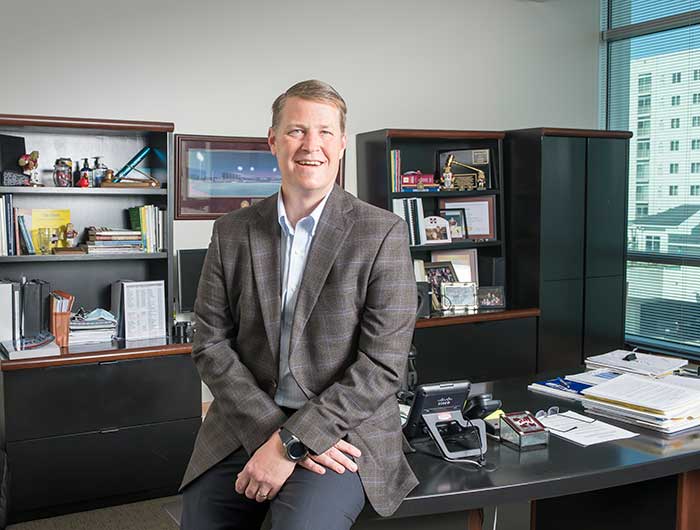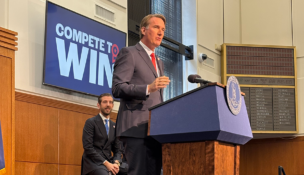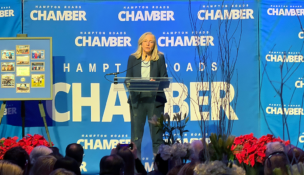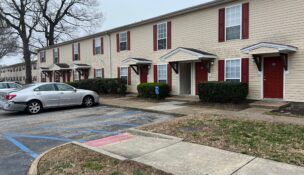Rolling out the red carpet
Tourism destination branches into tech, offshore wind
Rolling out the red carpet
Tourism destination branches into tech, offshore wind
With high-speed subsea internet cables landing on Virginia Beach‘s shores and massive wind turbines propelling off its coast, the state’s largest city is primed to welcome new businesses and industries generating high-end jobs.
“Virginia Beach is going to be the epicenter of economic development on the East Coast,” says Mayor Bobby Dyer. “I am convinced of that. That’s my personal mission.”
Focusing on technology and renewable energy, Virginia Beach seeks to attract more high-tech industries, including those that would use the trio of the world’s fastest subsea cables that come ashore at Telxius’ 24,000-square-foot landing station in the Virginia Beach Development Authority’s Corporate Landing Business Park. MAREA, owned by Microsoft, Facebook and Telxius, connects the city to Spain, while Telxius’ BRUSA cable links Brazil to Puerto Rico and Virginia Beach. Google’s Dunant submarine cable, which became operational earlier this year, connects Virginia Beach with Spain, Brazil and France. A fourth cable traveling from New York City to near Miami and branching off to Virginia Beach, Myrtle Beach, South Carolina, and Jacksonville Beach, Florida, also is in the works, and city officials have discussed bringing in 14 additional cables in the near future.
Located between General Booth Boulevard and Dam Neck Road, Corporate Landing Business Park is on track to become a mid-Atlantic hub for intercontinental subsea cables. Taking advantage of the park’s direct connection to the subsea cables, Globalinx and PointOne are developing data centers designed to attract large cloud computing companies along the lines of Amazon.com Inc., Netflix and Facebook, as well as military and government tenants. “Our facility is designed to accommodate customers who use subsea cables, but it’s also designed for local businesses that need data enterprises,” says Colin Clish, chief operating officer of Alberta, Canada-based PointOne.

Ben Davenport is focused on attracting more high-tech jobs for local college graduates. Photo by Mark Rhodes
Virginia Beach also wants to attract industries supplying components for East Coast offshore wind farms, including Richmond-based Dominion Energy Inc.’s Coastal Virginia Offshore Wind Project. In a pilot phase designed to generate energy for 3,000 homes, Dominion installed two massive, 600-foot-high wind turbines
27 miles off the Virginia Beach coastline last summer. By 2026, Dominion plans to build a major offshore wind farm there, erecting 188 turbines in adjacent waters — enough to power more than 650,000 homes. Achieving that ambitious goal will require establishing a wind energy construction supply chain that economic development officials foresee as becoming an East Coast hub as future offshore wind operations come online.
“With that plethora of technology, there will be potential job opportunities as we attract companies,” Dyer adds. “This is a really desirous location for a lot of businesses, and we’re going to roll out the red carpet for them.”
Cable ready
A technology and innovation task force, chaired by former Virginia Beach City Council member Ben Davenport, is examining the city’s ability to attract high-end tech jobs and increase workforce-training opportunities. “One of the problems we have in Virginia Beach is a lack of job opportunities for recent college graduates,” Dyer says. “We want to create situations where people’s children can find jobs here and keep families intact. That’s the ultimate economic development objective.”
Davenport, vice president of strategic development at Global Technical Systems, adds that the city is a prime location for technology enterprises. “We want to continue the momentum in building the technology ecosystem in Virginia Beach and ultimately in all of Hampton Roads,” he says. “If we continue down the road we’re on and make this an attractive place economically for internet ventures, we will have tremendous success. There are a lot of opportunities we are going to be chasing.”
Along with the subsea cables, Virginia Beach has one of the state’s lowest tax rates for data center equipment and one of the lowest municipal tax rates in the country, and officials worked with the U.S. Navy to establish the nation’s first cable landing protection area. “We’ve created a business environment that incentivizes the location of these activities,” says Virginia Beach Economic Development Director Taylor Adams.
Site work has been completed and the foundation poured for the first phase of NAP (Network Access Point) of Virginia Beach, a spec data center under development across from the cable landing station. The project was announced in late 2018, but work was suspended because of the pandemic. Now, PointOne is negotiating with potential tenants as it prepares to resume construction on the first of two 39,530-square-foot buildings on the 10.7-acre site. “We’re in the leasing stage with potential customers, but we don’t plan to start construction on the building until we secure a major tenant,” Clish says.
Additionally, the center will be able to accommodate growth from the existing cables, as well as new cables landing in Virginia Beach. “Virginia Beach is absolutely going to see two to five new cables in the next three to five years,” Clish adds.
Although there is room for more subsea cables, the city does not have available land to house massive data centers like Facebook’s 500-acre Henrico facility. “Virginia Beach doesn’t have that possibility,” Davenport acknowledges. “But we can work with other regional localities with more available landmass. As the region succeeds, our city succeeds.”
Wind energy
Virginia Beach also is spearheading efforts to boost Hampton Roads’ role in constructing a supply chain for the offshore wind industry. “Virginia Beach is a leader, but it’s too big of an initiative for any one city to act alone,” Adams says, noting that Dominion Energy’s offshore wind farm is one of eight to 10 similar projects on the East Coast. “There certainly is enough volume to see some of the suppliers locally here. I don’t think anybody fully knows the ultimate opportunities of companies coming here.”
Dominion Energy’s offshore wind farm also could help Hampton Roads attract data centers, adds Davenport. “Data centers are huge consumers of power,” he notes. “Dominion’s project paints the perfect picture of why Virginia Beach and Hampton Roads are one of the best places in the country for data centers. There will be an abundance of clean, renewable energy off the coast. Most in the data center industry see that as a big-time plus.”
To ensure local labor is prepared to support these emerging industries, the city has allocated $1 million for a Tidewater Community College program to teach skills to support offshore wind and is engaging with TCC and Old Dominion University to address high-tech workforce issues. Virginia Beach also is working with the military to ensure the more than 13,000 officers and enlisted personnel leaving the Navy each year can transfer their experience into local jobs.
“Many of those individuals come out with skill sets that are perfect for the technology industry,” Davenport says. “We have to create a technology economy here in Hampton Roads and ensure that we place them in opportunities where they will stay in Virginia Beach.”
Meanwhile, the city is partnering with Naval Air Station Oceana to explore economic development opportunities around the massive installation. Freeing up land around Oceana would help reduce the base’s overall costs and bring additional tax revenues to the city, says Dyer. “It’s still early in the process, but there is a plethora of potential there that the Navy is embracing with us.”
Overall, Virginia Beach’s economy remains strong despite the COVID-19 pandemic. Last year, more than 1,700 jobs were created in the city, representing a nearly $228 million investment and projected tax revenues of $55.8 million over the next two decades. “We’re really an economic engine for the entire region,” says Adams, noting that manufacturing, defense, logistics, office and tourism sectors continue to perform well, while the city’s unemployment rate is recovering from the pandemic. “We’re confident we’re on the road back to where we were.”
Engine trouble?
Dyer attributes Virginia Beach’s economic growth to business owners’ tenacity and resilience. “A lot of credit goes to the strength of Virginia Beach and the people of Virginia Beach who live, work and have businesses here,” he says. “Our strengths are our people, [who] make Virginia Beach a true, desirable destination where people are welcomed.”
One of the state’s top tourism destinations, Virginia Beach recorded the country’s highest hotel occupancy for 18 consecutive weeks last year amid the pandemic. “Once the beaches opened, that certainly helped,” Dyer says. “People could come to the beach for a healthy weekend.”

an attractive environment for data centers, says city Economic Development Director Taylor Adams. Photo by Mark Rhodes
Many visitors attend events at the $70 million Virginia Beach Sports Center that opened last fall at the oceanfront. Featuring 12 basketball courts, 24 volleyball courts, a 200-meter track and seating for 5,000 spectators, the 285,000-square-foot facility has already welcomed several NCAA tournaments. “It hit the market during the pandemic and has been fully booked,” says Adams.
Expectations are high that Atlantic Park will enjoy similar success. A $325 million public-private partnership between the city, Venture Realty Group and music superstar Pharrell Williams, the project will include a surf park, apartments, retail offices and an entertainment venue on 10 acres between 18th and 19th streets. Construction is expected to begin late this year.
“Atlantic Park is a very big part of the oceanfront’s future,” says Dyer. “If you give people things to do that are fun and entertaining, it makes for a better situation.”
Tourism is one of Virginia Beach’s major economic engines, but the luster has faded in some areas of the oceanfront. In response, the city revived its Resort Management Office to enhance the 40-block commercial district. The office will interact with visitors, promote safety, address homelessness issues and encourage property owners to update signage, awnings and other infrastructure.
Safety at the oceanfront has come under increased scrutiny after two people died (including a cousin of Williams who was shot by a police officer) and eight others were injured during a chaotic night of gunfire in late March. In response, City Council approved a $1.87 million public safety plan, including adding security cameras and lighting and a gunshot
detection system.
Still, local officials stress that the violence was an isolated event, and they tout rankings in recent years listing Virginia Beach as one of the country’s safest large cities. “The city is being proactive, and we’re confident we will have a safe season going forward,” Dyer says. “We want people to come to the oceanfront, but we expect them to respect the law and each other.”
S
















